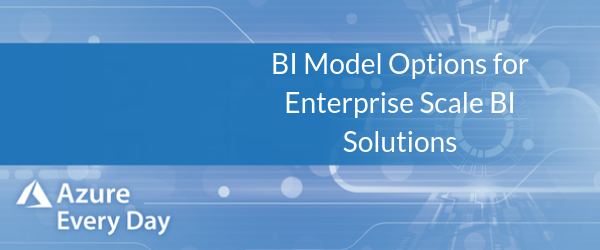Newsletter
Join our blog
Join other Azure, Power Platform and SQL Server pros by subscribing to our blog.


-1.png)
Start with the FREE community plan and get your lifetime access to 20+ courses. Get Instant Access Now!
Need help? Talk to an expert: (904) 638-5743

 In today’s post I’d like to talk about a hot topic for me and for many of my clients lately. This topic is about enterprise scale BI solutions—serious solutions involving Power BI.
In today’s post I’d like to talk about a hot topic for me and for many of my clients lately. This topic is about enterprise scale BI solutions—serious solutions involving Power BI.
Basically, we have 3 options in how to develop and deploy our data model: Power BI Desktop, Analysis Services on premises or Azure Analysis Services. Let me break these down.
1. Power BI Desktop – You can use this to develop the model and deploy to the Power BI Service. Developing models as we’ve always done here has some limitations but that feature set and those capabilities are being expanded very quickly.
2. Analysis Services on premises – We can use Analysis Services Tabular and if you’ve established Analysis Services multi-dimensional models, you can also use those. I, myself though, am not using multi-dimensional for new projects.
3. Azure Analysis Services – This is Analysis Services Tabular in the cloud. This is a great option with cost savings with hardware investment and licensing since you just pay for use.
Let me tell you why I’m considering using Power BI Desktop and the Power BI Service instead of using Analysis Services. Simple, that’s where the product team is putting a lot of their resources. Although it’s important to consider that you should have an appetite for new features and the rapid pace of design that Microsoft seems to be promoting lately.
If you’re ok with that, I would take a serious look at continuing to use Power BI Desktop and Power BI Service to implement your models. With this option we have incremental refresh, row level security and many other great features that are coming and evolving quickly.
On the other hand, if you want to slow down a bit and already have a cadence around developing Analysis Services, continue to use Visual Studio SSDT for your development. Then your choice will be whether to deploy on prem where you already have hardware or deploy to Azure Analysis Services.
So, try it out, do what works for you. It’s pretty inexpensive to get started and then do the math to figure out what a production implementation is going to look like. If you have any questions around this topic or anything Azure related, you’re in the right place. Click the link below or contact us – we’re here to help you every step of the way in your cloud and BI journey.

Free Community Plan
private training
Newsletter
Join other Azure, Power Platform and SQL Server pros by subscribing to our blog.


-1.png)
Leave a comment